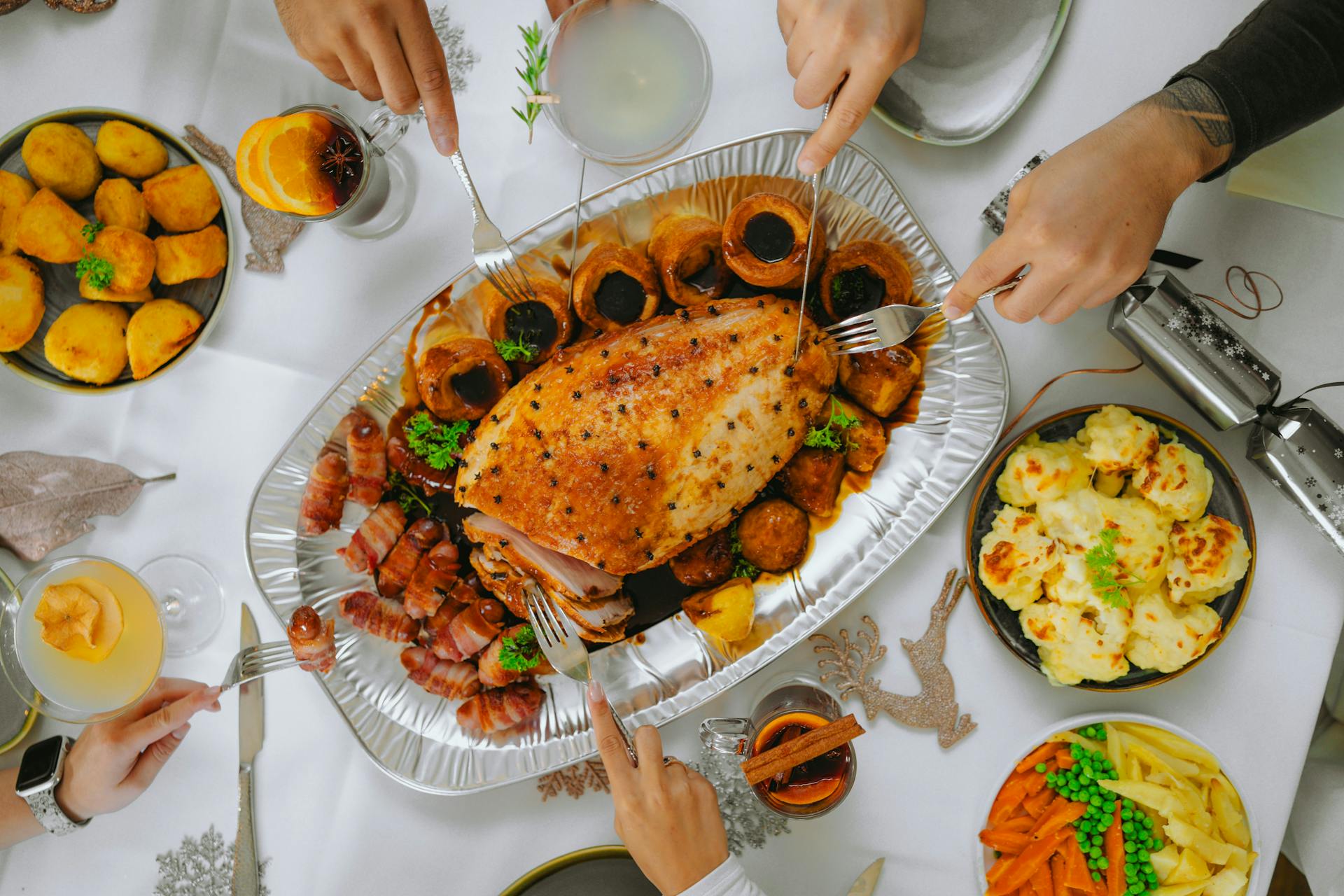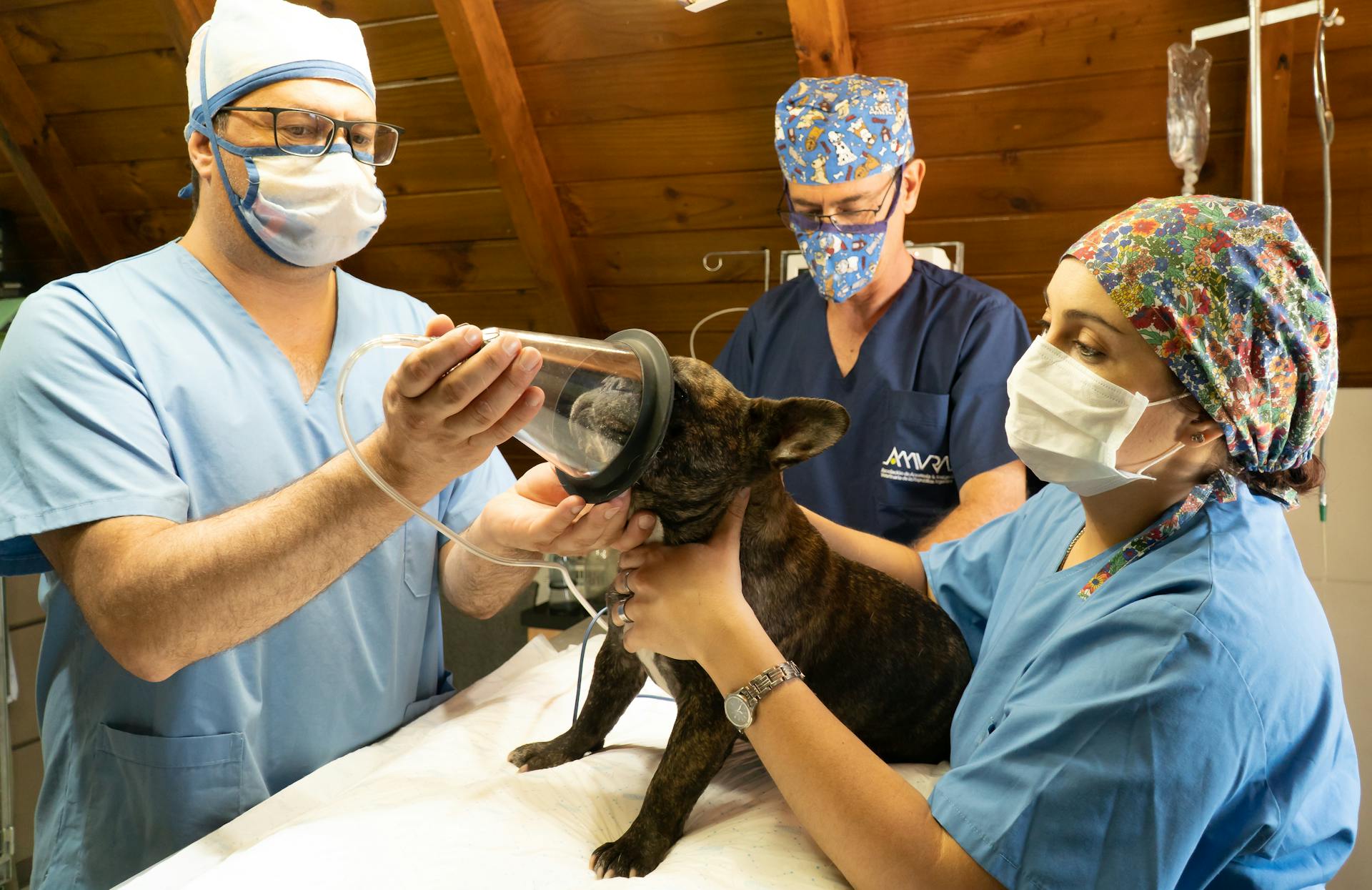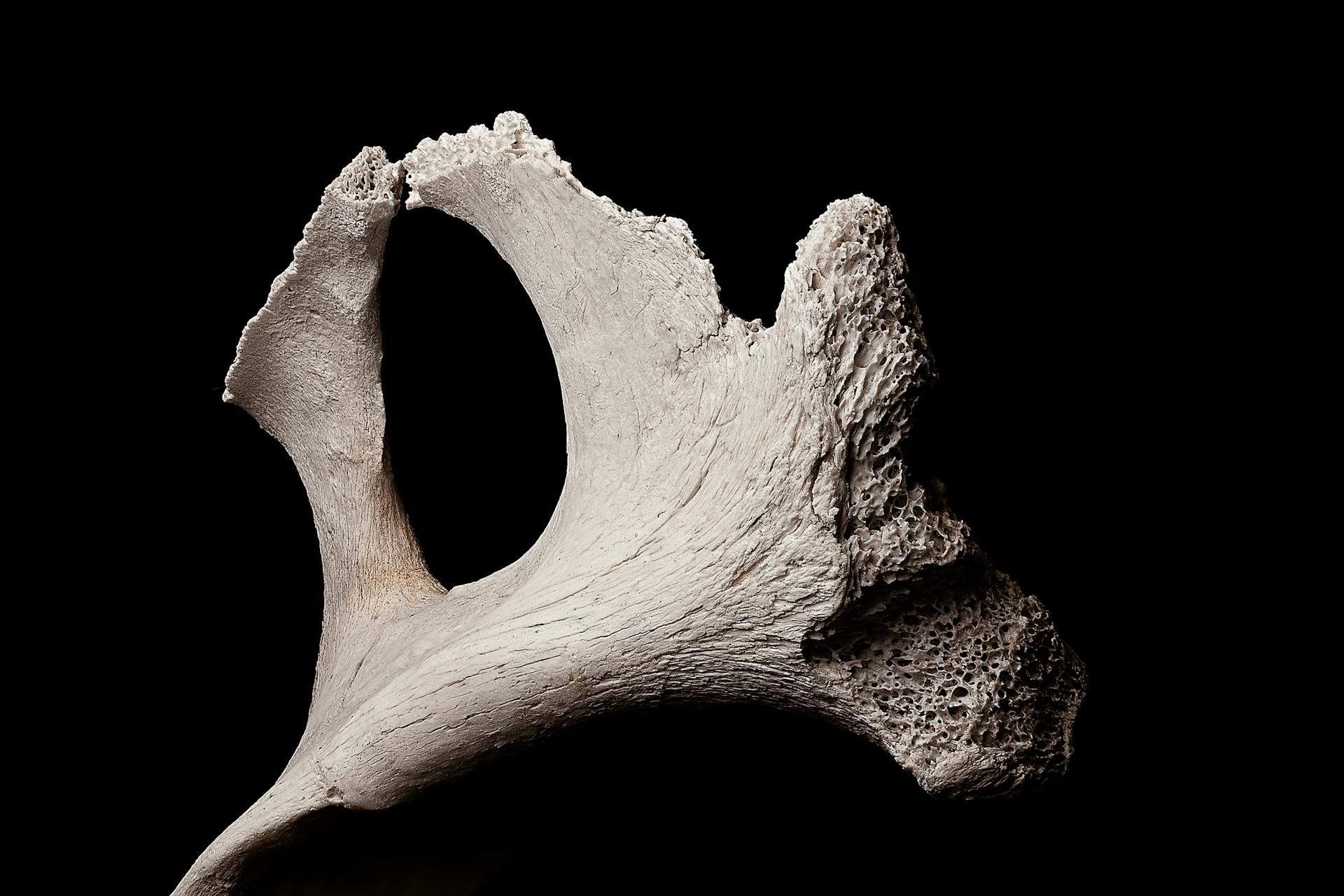
Meat bones can be a nutritious and delicious addition to your dog's diet. They're a natural source of calcium, which is essential for maintaining strong bones and teeth.
Dogs have been eating meat bones for thousands of years, and many breeds were originally developed to thrive on a diet that included bone.
Meat bones come in various shapes and sizes, and some are better suited for your dog than others. Look for bones that are large enough for your dog to gnaw on safely.
Your dog's age, size, and breed will also play a role in determining the best meat bones for them.
Discover more: Bone Stuck in Dogs Mouth
Raw Meat Bones
Raw meaty bones are a staple in a raw diet for dogs. They provide essential calcium and other nutrients that help create firm stool. However, it's crucial to select safe raw meaty bones.
Raw meaty bones are edible bones covered in raw muscle meat and connective tissues. They can be fed whole or in ground form. The USDA Food Database provides nutritional data on muscle meat, skin, and fat from raw meaty bones, but not on the vitamin and mineral content found within the bones.
For small breeds, all recommendations can be fed, and medium breed dogs are flexible when it comes to providing raw meaty bones. It's essential to choose bones appropriate for the size of the dog consuming them.
Raw bones are generally safer than cooked bones, but still pose risks. Your dog can break a tooth, cut their gums, or get a bone splinter. To minimize risks, get raw bones from a reputable butcher and refrigerate them before use.
Here are some guidelines for selecting safe raw bones:
- Get raw bones from a reputable butcher
- Choose bones that are large enough to be easily grasped and about the size of your dog's head
- Select bones with bulges or lumps on both ends
Types of Bones
Raw meaty bones are essential in a raw diet to provide necessary calcium and other nutrients for dogs. They can be fed whole or in ground form.
Medium breed dogs are flexible when it comes to providing RMBs.
Necks
Chicken, turkey, and duck necks are excellent raw meaty bone options to include in raw diets to meet edible bone requirements.
Raw necks are a good raw meaty bone to promote teeth cleaning from chewing.
Many grocery stores carry machine-cut neck bones without much meat attached to the bones.
It's best to avoid feeding these bones because of the sharp edges from machine cutting and because there is no muscle meat covering the bone.
Ribs
Ribs are a great option for medium to giant breeds, but be sure to feed them in groups of 2-3 ribs to avoid choking hazards.
Pork, lamb, and goat ribs are safe to feed, but it's best to steer clear of beef ribs due to their denser bones, which increase the risk of tooth fractures.
Feeding ribs in groups is a must, as singular bones can be a serious choking hazard for our furry friends.
Worth a look: Food Alternatives for Dogs
Turkey Legs/Drumsticks
Turkey legs and drumsticks are a popular choice for dog owners, but it's essential to be aware of their dense bones that can splinter when broken.
These bones are risky to feed dogs, so it's recommended to remove the muscle meat from the bone.
The boneless meat can be fed to dogs, but the bone itself should be used for bone broth.
Beef
Beef bones are a bit tricky to work with. Whole beef bones are very dense and can cause tooth fractures and impaction in pets.
You might enjoy: Dogs Eat Beef Neck Bones
Ground beef bones, on the other hand, are safe to feed as they don't pose a choking hazard. This is a great option if you're looking for a beef-based raw meaty bone.
If your pet has gulping tendencies, it's recommended to feed larger items to encourage chewing and prevent choking. This is especially important for smaller pets or those with swallowing issues.
Check this out: How Much Raw Meat to Feed Dogs
Pork Trotter
Pork Trotter is a great option for dogs and cats on raw diets. It contains a moderate amount of edible bone content, making it suitable for their nutritional needs.
For dogs, a 10-15% edible bone content is ideal, and Pork Trotter can help meet that requirement. This means that for every 100 grams of Pork Trotter, 10-15 grams should be edible bone.
Broaden your view: Is Pork Meat Bad for Dogs
Find the Right
When selecting raw meaty bones, it's essential to choose ones that match your pet's size.
For medium breed dogs, the options are quite flexible, allowing you to pick from a variety of bones.
Small breed dogs can also be fed the same recommendations as medium breed dogs.
Raw meaty bones can be fed whole or in ground form to provide essential calcium and other nutrients.
A combination of sources is needed to analyze the nutrient content of raw meaty bones, as the data is not widely available.
The USDA Food Database provides nutritional data on muscle meat, skin, and fat from raw meaty bones, but not on the vitamin and mineral content of the bones themselves.
Bone Safety
Raw bones are generally safer for dogs than cooked bones, but they can still cause problems if not chosen and handled properly. Always select raw meaty bones that are safe to feed in raw diets.
Some breeds of dogs, such as brachiocephalic breeds like boxers, bulldogs, pugs, and Shih Tzus, are not mechanically designed to chew bones effectively and safely. These dogs should not eat bones and may be better off with a Kong toy instead.
For your interest: Dog Breeds Watch Dogs
If you do choose to give your dog a bone, it's essential to supervise them closely to prevent any potential harm. Large bones are generally safer than small ones, but even large bones can cause problems if not handled correctly.
Here are some general safety rules to follow when giving your dog a bone:
- Serve raw meat bones.
- After 10 to 15 minutes, remove the bone from your dog and place it in the refrigerator.
- After three or four days, discard the bone.
- Give large bones to large breeds like German Shepherd Dogs, Bloodhounds, and Mastiffs.
- Keep an eye on your dog when they're chewing on a bone.
Remember, even raw bones can introduce food-borne pathogens like Salmonella into your household, so it's crucial to handle them safely and discard them after a few days.
General Safety Rules
Always select raw meaty bones that are safe to feed in raw diets. These bones should be from a reputable butcher and large enough to be easily grasped by your dog.
To ensure bone safety, serve raw meat bones to your dog. After 10 to 15 minutes, remove the bone from your dog and place it in the refrigerator. This will help prevent any potential health issues.
If you're giving your dog a bone, keep an eye on him at all times. This will help prevent any accidents or injuries.
Here are some general guidelines for bone safety:
- Serve raw meat bones.
- Remove the bone after 10 to 15 minutes and refrigerate it.
- Discard the bone after three or four days.
- Give large bones to large breeds like German Shepherd Dogs, Bloodhounds, and Mastiffs.
- Supervise your dog when giving him a bone.
Remember, even raw bones can cause harm if not handled properly. Be an educated consumer and take necessary precautions to ensure your dog's safety.
Toy Safety for Dogs
If you have a Brachiocephalic breed like a Boxer, Bulldog, Pug, or Shitzu, feeding bones isn't a good idea. Their jaw structure isn't designed to chew bones effectively and safely.
A Kong toy is a great alternative for these breeds, as it can provide a similar chewing experience without the risk.
Little dogs and toy breeds with delicate jaw structures and softer teeth shouldn't eat bones at all.
If your dog is too small to eat bones safely, you can still help maintain their dental health with a mix of hydrogen peroxide and aloe vera juice.
Dogs with gut sensitivities might not process bones well, so if your dog is prone to loose stools or vomiting, it's best to resolve those issues first before giving them bones.
For another approach, see: Dogs Eat Cooked Chicken Bones
Nutrition and Benefits
Meat bones can be a nutritious addition to your dog's diet, providing essential minerals like calcium and phosphorus. These minerals are crucial for maintaining a healthy skeletal system, and can even help regenerate and adapt bones.
While bones themselves aren't a significant source of nutrition, the attached soft tissues like meat, cartilage, and fat are. If you're considering adding meat bones to your dog's meals, be sure to source them from a reputable butcher and follow proper food hygiene to minimize the risk of food-borne illness.
To maximize the benefits and minimize the risks, it's essential to grind the bones thoroughly before including them in your dog's meals. Softer options like chicken necks tend to work best.
Chewing on bones can also help stimulate saliva enzymes, which aids in the prevention of plaque buildup and gum disease. This can be especially beneficial for dogs that tend to get stuck with food particles in their teeth.
Here are some key benefits of providing meat bones for your dog to chew on:
- Provides essential minerals like calcium and phosphorus
- Helps stimulate saliva enzymes to prevent plaque buildup and gum disease
- Satisfies your dog's appetite and can help deter undesirable behaviors like excessive scratching or licking
- Helps maintain a healthy skeletal system by providing the necessary nutrients for bone regeneration and adaptation
Proper Feeding Schedule
When giving your dog a bone, it's essential to pay attention to the timing. Give a bone after a full meal to ensure your dog isn't starving while chewing on it.
Ingesting too much of a bone can lead to constipation and serious obstruction, so it's crucial to limit the time your dog spends with a bone. Give your dog a bone for only 10 to 15 minutes.
After removing the bone, wash it and store it in the fridge. Toss it out after 3-4 days to prevent bacterial growth.
Replacing the bone with a treat, like mozzarella cheese, can help reduce the likelihood of behavioral issues like resource guarding.
Frequently Asked Questions
What chew bones do vets recommend?
Vets recommend bully sticks as a healthy and easy-to-digest chew option for dogs. These natural, palatable chews are a great alternative to traditional bones.
Sources
- https://perfectlyrawsome.com/raw-feeding-knowledgebase/raw-meaty-bones-rmb/
- https://theanimalkeeper.com/caution-bones-can-kill-your-dog-find-out-which-ones-are-safe/
- https://www.advancedcareanimalclinic.com/site/blog/2023/02/15/dog-bone-safely
- https://www.petmd.com/dog/nutrition/evr_dg_raw_bones_or_cooked_bones
- https://www.drbasko.com/portfolio-items/throw-bone-4-tips-feeding-bones-dogs-safely/
Featured Images: pexels.com


